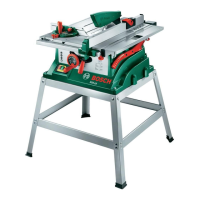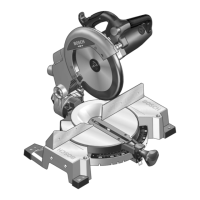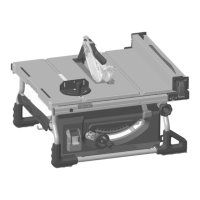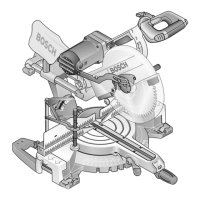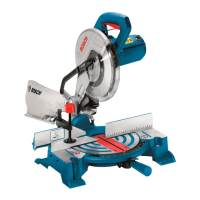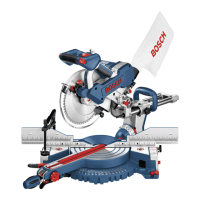English–121 609 929 J73 • (06.03) PS
Adjusting the Auxiliary Parallel
Fence
(see Figure
)
When sawing small work pieces and vertical mi>
tre angles, the auxiliary parallel fence 48 must be
mounted on the parallel fence 7.
When sawing short work pieces, they can become
jammed between the parallel fence and the saw blade
35 where they are caught by the upward$moving part
of the saw blade and slung away. Therefore, adjust the
auxiliary parallel fence so that it ends in the area be$
tween the foremost teeth of the saw blade and the
front edge of the riving knife 4.
For this purpose, loosen all attachment screws 51 and
slide the auxiliary parallel fence 48 accordingly.
Retighten the screws.
When sawing high work pieces, mount the auxiliary
parallel fence 48 vertically on the parallel fence 7.
Putting into Operation
Switching On
Slide the red EMERGENCY OFF button 14 to the left
and open the yellow safety flap 28 (see Figure ).
To put into operation, press the green switch$on but$
ton 63 and then close the safety flap again (see
Figure ).
Switching Off
(see Figure )
Press the red EMERGENCY$OFF button 14.
Power Failure
The on/off switch is a so$called zero voltage switch
that prevents restarting of the power tool after a power
outage (e.g., when the mains plug is pulled during op$
eration).
To put the power tool back into operation, the green
"On" switch 63 must be pressed again.
Working Instructions
Before all work on the machine, pull the mains
plug.
General Sawing Instruction
Before all cuts, it must first be ensured
that the saw blade cannot come in con>
tact with the fence, guide or other ma>
chine parts.
Protect the saw blade from strikes and shocks. Do not
apply side pressure to the saw blade.
Before using, mount the power tool on a flat and sta$
bile work surface, e.g., workbench.
Take care that the riving knife is in line with the saw
blade for all bevel angles.
Do now work with warped work pieces. The work
piece must always have a straight edge that can be
rested against the parallel fence.
Always store the pusher piece on the power tool.
Do not use the power tool for rebating, grooving or
slotting.
Marking the Cutting Line
(see Figure
)
On the round yellow sticker 8, mark the cutting line of
the saw blade. In this manner, the work piece can be
positioned exactly for sawing.
Hand Placement
Keep hands, fingers and arm away from the rotating
saw blade.
Hold the work piece securely with both hands and
press it firmly against the saw table, especially when
working without a fence or guide.
(see Figures and )
For the sawing of small work pieces and vertical mitre
angles, always use the pusher piece provided and the
auxiliary parallel fence 48 (see Figure ).
Maximum Work Piece Height
I
J1
J2
J3
Vertical Bevel An>
gle
Maximum Height
of the Work Piece
90° 75 mm
45° 63 mm
K
L1 L2
L3
PTS10_WEU.book Seite 12 Donnerstag, 23. März 2006 11:47 11
